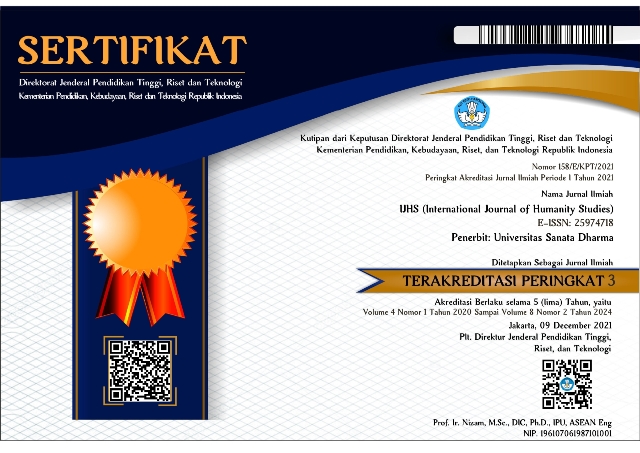BETWEEN HINDU INDONESIA AND THE HARE KRISHNA MOVEMENT: A MINORITY PROBLEM
(1) Center for Religious and Cross-cultural Studies, Indonesia
(*) Corresponding Author
Abstract
The conflict between Hindu Indonesia or Indonesian Hinduism and Hare Krishna movements in Indonesia is between two religious groups that are not solely about theological differences but also political. Under Parisada Hindu Dharma Indonesia (PHDI), Indonesian Hinduism gained recognition from the state after making several adjustments and changes. The entanglement of Indonesian Hinduism and Balinese cultures was knitted during the struggle for recognition. It led to a fixed, specific identity and character of Indonesian Hinduism. The case of a series of rejections toward the Hare Krishna movement sparked in the Hindu members who escalated with Desa Adat involvement and reached a deadlock with the statements of PHDI. This paper investigates the issues between Indonesian Hinduism and the Hare Krishna Movements through a literature review. It aims to answer questions about how the conflict between Indonesian Hinduism and the Hare Krishna movements presents the complexities of the socio-cultural politics of governing religion in Indonesia. Finally, it argues that the conflict between Indonesian Hinduism and the Hare Krishna movement reflects the effects of governing religious differences in Indonesia.
Keywords
Full Text:
PDFReferences
Artaya. (2022, July 31). Polemik Hare Krishna, pusat terima laporan tim kerja PHDI Bali. Atnews.id. https://atnews.id/portal/news/5790.
Media Pers Indonesia (2021). Ashram Krishna Balaram Padang Galak ditutup Desa Adat Kesiman. https://persindonesia.com/2021/04/19/ashram-krishna-balaram-padang-galak-ditutup-desa-adat-kesiman/.
Beck, G. L. (2004). Hare Krishna Mahamantra: Gaudiya Vaishnava practice and the Hindu tradition of sacred sound. In E. Bryant & M. Ekstrand (Eds.), The Hare Krishna movement: The postcharismatic fate of a religious transplant (pp. 35–44). Columbia University Press.
Dae, A. (2020, August). Ribuan umat Hindu demo tolak ajaran Hare Krisna hadir di Bali. Fajarbadung.com. https://fajarbadung.com/ribuan-umat-hindu-demo-tolak-ajaran-hare-krisna-hadir-di-bali/9237/2020/.
Doktrinaya, I. K. G. (2021, September 9). ISKCON sah secara hukum, Komnas HAM keluarkan rekomendasi. Baliexpress. https://baliexpress.jawapos.com/nusantara/671169475/iskcon-sah-secara-hukum-komnas-ham-keluarkan-rekomendasi.
Esposito, J. L., Lewis, T. T., & Fasching, D. J. (2018). World Religions Today (6th ed.). Oxford University Press.
Hartaka, I. M., & Diantary, N. M. Y. A. (2020). Meningkatkan kesadaran individu melalui ajaran karmaphala. Widya Katambung, 11(1), 18–33. https://doi.org/10.33363/wk.v11i1.503.
Hurd, E. S. (2015a). Believing in religious freedom. In W. F. Sullivan, E. S. Hurd, S. Mahmood, & P. G. Danchin (Eds.), Politics of religious freedom. University of Chicago Press.
Hurd, E. S. (2015b). Beyond religious freedom: The New Global Politics of Religion. Princeton University Press.
International Society for Krishna Consciousness. (n.d.). What is ISKCON? Retrieved December 12, 2022, from https://www.iskcon.org/about-us/what-is-iskcon.php.
Kuckreja, R. (2022). The Hare Krishnas in Bali: Localized religion and new religious movement. Religió: Jurnal Studi Agama-Agama, 12(1), 1–22. https://doi.org/10.15642/religio.v12i1.1857.
Panyatman, O. (2019). Panca Sradha. ESBE Buku.
Picard, M. (2004). What’s in a name? Agama Hindu Bali in the making. In M. Ramstedt (Ed.), Hinduism in modern Indonesia: A minority religion between local, national, and global interests (pp. 56–75). RoutledgeCurzon.
Picard, M. (2011). From Agama Hindu Bali to Agama Hindu and back: Toward a relocalization of the Balinese religion? In M. Picard & R. Madinier (Eds.), Politics of religion in Indonesia (pp. 117–141). Routledge.
Porosbali.com. (2021, September 10). MDA Bali tetap larang ISKCON dan Hare Krishna terkait rekomendasi Komnas HAM. Porosbali.Com. https://www.porosbali.com/read/202109110003/mda-bali-tetap-larang-iskcon-dan-hare-krishna-terkait-rekomendasi-komnas-ham.html.
Santika, N. W. R. (2017). Pemahaman konsep teologi Hindu (Perspektif pendidikan agama Hindu). Bawi Ayah: Jurnal Pendidikan Agama dan Budaya Hindu, 8(1), 87–97. https://doi.org/10.33363/ba.v8i1.303.
Schweig, G. M. (2004). Krishna: The intimate deity. In E. Bryant & M. Ekstrand (Eds.), The Hare Krishna movement: The postcharismatic fate of a religious Transplant (pp. 13–30). Columbia University Press.
Sudibya, I. G. (2021, June 29). Dresta Bali, pemikiran kritis—reflektif, atnews.id. https://atnews.id/portal/news/9063.
Suhardana, K. M. (2006). Pengantar etika dan moralitas Hindu: Bahan kajian untuk memperbaiki tingkah laku. Paramita.
Ulum, R., & Firdausi, L. (2021). Resistance of Hindu traditionalists against Sampradaya Hare Krishna Bali. Analisa: Journal of Social Science and Religion, 6(2), 235–252. https://doi.org/10.18784/analisa.v6i02.1432.
Watra, I. W. (2007). Pengantar filsafar Hindu (Tattwa 1). Paramita.
Widana, I. G. K. (2021, May). Sampradaya. Bali Post. https://www.balipost.com/news/2021/05/17/192311/Sampradaya.html.
Yin, R. K. (2018). Case study research and applications: Design and methods (6th edition). SAGE.
DOI: https://doi.org/10.24071/ijhs.v8i2.8164
Refbacks
- There are currently no refbacks.
Copyright (c) 2025 Yohanes Babtista Lemuel Christandi

This work is licensed under a Creative Commons Attribution-ShareAlike 4.0 International License.
Indexed and abstracted in:
IJHS Sinta 3 Certificate (S3 = Level 3)
International Journal of Humanity Studies (IJHS) has been nationally accredited Sinta 2 by the Ministry of Higher Education, Science, and Technology of the Republic of Indonesia based on the decree No. Surat Keputusan 0173/C3/DT.05.00/2025. Validity for 5 years: Vol. 7 No. 2, 2024 till Vol. 12 No. 1, 2029.

This work is licensed under CC BY-SA.
Creative Commons Attribution-ShareAlike 4.0 International License.
p-ISSN: 2597-470X (since 31 August 2017); e-ISSN: 2597-4718 (since 31 August 2017)
Notice: The opinions expressed in this publication are those of the authors. They do not purport to reflect the opinions or views of the editorial team or publishers.
International Journal of Humanity Studies (IJHS) is a scientific journal in English published twice a year, namely in September and March, by Sanata Dharma University, Yogyakarta, Indonesia.




















